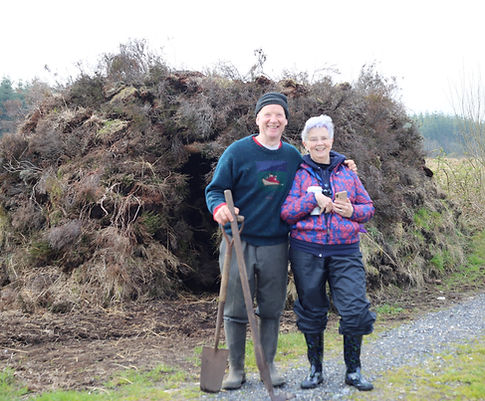
Boutique private farm stay accommodation & activities in the heart of rural Ireland

Ireland West Bog Experience
Ireland West Farm Stay boasts acres of beautiful Bog land as far as the eye can see. These Bogs are fascinating places that provide a glimpse into rural Ireland, its traditions, culture, heritage and history.
"Come join me on a exploration of the bogs of Ireland!" Eddie Joe Dooney
A bog is a wetland of soft, spongy ground consisting mainly of partially decayed plant matter called peat.
Bogs are generally found in cool, northern climates. They often develop in poorly draining lake basins created by glaciers during the most recent ice age.
For thousands of years, people have regarded bogs as spiritual or haunted places. Their spongy and sometimes slow-burning soil created mysteries for Bronze Age and Iron Age societies.
Perhaps the most lasting testament to ancient reverence for bogs are bog bodies. Bog bodies are the remains of people who died in bogs or were placed there after their deaths. More than a thousand bog bodies have been found throughout northern Europe.
All bogs take hundreds or thousands of years to develop. A bog is formed when a lake slowly fills with plant debris. Sphagnum moss, as well as other plants, grow out from the lake's edge. The vegetation eventually covers the lake's entire surface.
People have used peat extracted from the bogs as a source of fuel for centuries. Broken into blocks and burnt, the peat provides a soft warmth and earthy smell. With a visit to Ireland West Farm Stay you will experience the ancient practice of 'cutting the turf''.


The bogs are home to a diverse array of flora. The most common plants are Sphagnum mosses, bog cotton, heathers, purple moor grasses and black bog rushes. One very interesting plant is butterwort. Butterwort is an insectivorous plant, which means it attracts and eats insects. The bog cotton provides masses of fluffy white heads in late spring and summer. In late summer and autumn, the pink and purple carpet of heathers covers the upland slopes and valleys of the hills.
Boglands are home to various animals including... Birds like the snipe, curlew, skylark and kestral nest in the safety of boglands. The fox, deer, hare and otter live there too. Frogs are plentiful.
Dragonflies, craneflies, moths and butterflies are among the insects that like this habitat.
In their natural state peatlands act as long-term sinks for atmospheric carbon dioxide. A persistently high water table is necessary for this function. Peatlands are the most important long-term carbon store in the terrestrial biosphere. They sequester and store atmospheric carbon for thousands of years (Charman et al, 2008). The peatlands in the northern hemisphere alone store approximately 450 billion tonnes of carbon (Gorham, 1991).
Undisturbed peatlands accumulate carbon from the air at a rate of up to 0.7 tonnes per hectare per year (Pearce, 1994).

Join Eddie Joe on an exploration of the Ireland West Farm Stay bog and peatlands. You will learn about the history and heritage of the bogs of Ireland and also get to experience cutting the peat.
Contact us now to organise your bog tour in Mayo!


